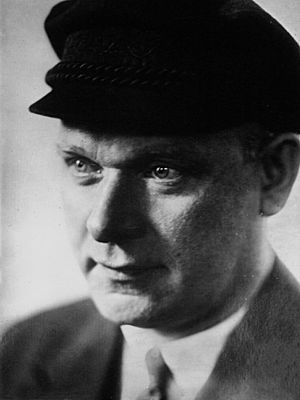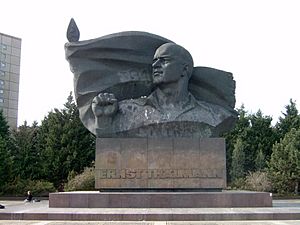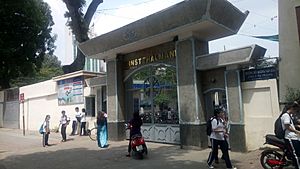Ernst Thälmann facts for kids
Quick facts for kids
Ernst Thälmann
|
|
|---|---|
 |
|
| Chairman of the Communist Party of Germany | |
| In office 1925–1933 |
|
| Preceded by | Heinrich Brandler |
| Succeeded by | Wilhelm Pieck |
| Member of the Reichstag | |
| In office 1924–1933 |
|
| Constituency | Hamburg |
| Personal details | |
| Born | 16 April 1886 Hamburg, German Empire |
| Died | 18 August 1944 (aged 58) Buchenwald concentration camp, Nazi Germany |
| Political party | KPD |
| Other political affiliations |
SPD (1903–1917) USPD (1917–1918) |
| Children | 1 daughter |
| Profession | Revolutionary, politician |
| Military service | |
| Allegiance | |
| Years of service | 1915–1918 |
| Battles/wars | World War I |
| Awards |
|
Ernst Thälmann (born April 16, 1886 – died August 18, 1944) was an important German communist politician. He led the Communist Party of Germany (KPD) from 1925 to 1933.
Thälmann was a strong believer in Marxism–Leninism. He played a big role during a difficult time in Germany, known as the Weimar Republic. Under his leadership, the KPD worked closely with the Soviet Union and its leader, Joseph Stalin.
Thälmann also led a group called the Roter Frontkämpferbund. In 1933, the Gestapo (secret police) arrested him. He was kept alone in prison for eleven years. Even though he was loyal to Stalin, he was not released. Thälmann was shot in Buchenwald concentration camp in 1944, on Adolf Hitler's direct orders.
Contents
Early Life and Family
Ernst Thälmann was born in Hamburg, Germany. His parents were Johannes Thälmann and Mary-Magdalene Kohpeiss. His father was a farmworker. His mother was very religious.
After Ernst was born, his parents ran a pub. Later, they opened a shop selling vegetables and coal. Young Ernst helped with the family business after school. He was a good student and loved learning.
He wanted to become a teacher or learn a trade. However, his parents could not help him financially. So, he had to keep working in their shop. This caused sadness and arguments. At age ten, he started working as an unskilled laborer at the port. There, he saw the big Hamburg Docker's Strike of 1896-1897. This showed him the struggles of workers.
Leaving Home and World War I
In 1902, Ernst Thälmann left his family home. He worked different jobs, including as a fireman on a steamship. In 1903, he joined the Social Democratic Party of Germany (SPD). He became a leader in a union for transport workers.
In January 1915, he married Rosa Koch. The next day, he was called to serve in World War I. He fought on the Western Front in many battles. He received several awards for his service, including the Iron cross Second Class.
Towards the end of 1917, he joined the Independent Social Democratic Party of Germany (USPD). In October 1918, he left the front lines while on leave. He wrote in his diary that he "did a bunk from the Front with 4 comrades."
Becoming a Communist Leader
After leaving the army, Thälmann became active in the German Revolution of 1918–1919 in Hamburg. He became chairman of the USPD in Hamburg in 1919. He also became a member of the Hamburg Parliament.
In November 1920, the USPD split. Thälmann joined the part that wanted to be with the Communist International (Comintern). This group then joined the KPD. In December, Thälmann was elected to the KPD's Central Committee.
In 1921, he lost his job because of his political work. That summer, he went to Moscow and met Vladimir Lenin. In June 1922, someone tried to assassinate him by throwing a grenade into his apartment. He survived.
Thälmann helped plan the Hamburg Uprising in October 1923. It failed, and he had to hide. After Lenin died in 1924, Thälmann visited Moscow. He stood guard at Lenin's coffin.
From February 1924, he was deputy chairman of the KPD. He also became a member of the Reichstag (German parliament). In 1925, he became chairman of the KPD. He also became a candidate for the German Presidency.
In the 1925 presidential election, Thälmann's candidacy split the votes on the left. This helped the conservative candidate, Paul von Hindenburg, win.
In 1928, there was a problem within the KPD. Thälmann was removed from a party committee for trying to hide a mistake by a friend. But Joseph Stalin stepped in and had Thälmann put back in his position. This showed Stalin's growing influence over the KPD.
KPD and SPD: A Difficult Relationship
After the 1918 Revolution, there were many conflicts in Germany. The government, led by the Social Democratic Party (SPD), sometimes used military force against communist uprisings.
In 1929, at a KPD meeting, Thälmann decided the KPD would strongly oppose the SPD. This happened after "Bloody May," when police killed 32 people during banned demonstrations.
Under Thälmann, the KPD saw the SPD as its main enemy. This made it very hard for the two big left-wing parties to work together. They could not unite against the rising power of Adolf Hitler and the Nazis. Thälmann believed that fighting fascism meant fighting the SPD as much as fighting Hitler.
In March 1932, Thälmann ran for German President again. He ran against Hindenburg and Hitler. The KPD's slogan was "A vote for Hindenburg is a vote for Hitler; a vote for Hitler is a vote for war." He did not win.
After the Nazis came to power in January 1933, Thälmann suggested that the SPD and KPD should go on a general strike. He wanted to stop Hitler's rule. But the SPD refused to work with the KPD. They remembered the years of conflict.
Imprisonment and Execution
After the Reichstag fire in February 1933, the Nazi government started arresting communists. Thälmann went into hiding, but he was arrested on March 3, 1933. He was taken from a safe house in Berlin.
Even after Germany and the Soviet Union signed a non-aggression pact in 1939, Thälmann was not released. Despite his loyalty to Stalin, Moscow did not push for his freedom. Some people in his own party, like Walter Ulbricht, ignored requests from Thälmann's family to help him.
Thälmann spent over eleven years in solitary confinement. In August 1944, he was moved to Buchenwald concentration camp. On August 18, 1944, he was shot there on Hitler's personal order. His body was immediately burned. The Nazis later falsely claimed he died in an Allied bombing attack.
Legacy
During the Spanish Civil War, some German volunteer groups were named after Thälmann. One famous group was the Thälmann Battalion. During World War II, a company of fighters in Yugoslavia was also named the Ernst Thälmann Company.
In 1935, a town in Ukraine was renamed Telmanove in his honor.
After 1945, Thälmann was greatly honored in East Germany. Many schools, streets, and factories were named after him. The East German children's organization was called the Ernst Thälmann Pioneer Organisation. Its members promised to learn and fight like Ernst Thälmann.
In the 1950s, a two-part East German film about his life was made. In 1972, Cuba named a small island, Cayo Ernesto Thaelmann, after him.
Today, streets and squares named after Thälmann can still be found in cities like Berlin and Hamburg. There is also a high school named after him in Ho Chi Minh City, Vietnam. A primary school in Ulaanbaatar, Mongolia, also carries his name.
See also
 In Spanish: Ernst Thälmann para niños
In Spanish: Ernst Thälmann para niños




